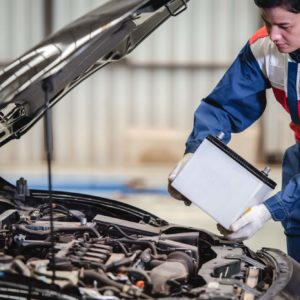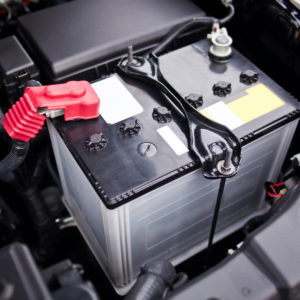Finding yourself stranded with a dead vehicle battery can be a nightmare. Perhaps you left your headlights on while at the store, or maybe your vehicle was in accessory mode for a little too long. Whatever the case, after jumpstarting your vehicle, you’re likely wondering how long it’ll take to charge a dead car battery. We’re here to satisfy your curiosity.
Note: The overall health of the battery should be good. Sometimes a dead battery got that way by killing itself or having a shorted cell that happens without warning. In these cases, there’s nothing to be done other than replacing the battery. This article covers charging a healthy battery that has been inadvertently drained. If the battery is more than three years old, it may be running low on cold cranking amps by default.
Car Battery Charging Time
After jumpstarting your vehicle, you can go ahead and let the engine run. Keep the engine running for at least 30 minutes. Driving a car does charge the battery, and does a better and faster job of it than any battery charger. As long as the engine is running, a healthy alternator will charge the battery in short order.
It should take 30 minutes to sufficiently charge your vehicle’s battery, but the battery can, when the vehicle is being driven, reach a serviceable level of charge in as little as 10 minutes. A healthy alternator is very powerful and efficient.
It’s also best to drive your vehicle around rather than letting it sit idle. Driving at higher speeds means the engine is running at higher than idle speeds most of the time, and that spins the alternator faster.
This is, of course, only for regular vehicles. If your electric vehicle (EV) runs out of charge, you need to bring it to the nearest charging station.
Electric Vehicle Battery Chargers
Fully charging your EV battery can take as fast as 30 minutes or less if it has a typical 60 kilowatt-hour (kWh) battery and you’re using a 150 kilowatt (kW) rapid charging station. Using a 7kW charger will take 8 hours, and a 22kW charger will take 3 hours. Some slower home chargers at 3.7kW will take 16 hours to fully charge a 60kWh battery.
Regular Vehicle Battery Chargers
If your vehicle’s alternator isn’t keeping your vehicle fully charged, you might need to rely on an external car battery charger to top it up.
It’ll take four to eight hours of charging to fully charge a normal vehicle battery with a smart or automatic vehicle battery charger. These chargers provide slow charging with relatively high voltage. It’ll take days to fully charge a battery with a trickle charger. Trickle chargers are mainly for topping up the batteries in vehicles you don’t use often, so if you’re in a hurry, they aren’t ideal unless you have the time to let them charge the battery overnight or for a whole day.
Shop-grade professional battery chargers will have different charge level settings and a timer that can be set to charge the battery for a certain amount of time or continuously, depending on where you set the timer knob.
The problem with fast-charging a battery using a heavy duty shop-grade charger is that it tends to overheat the plates in the battery, boil the electrolyte, and can shorten the life of a battery if the battery is fast charged too often.
Home-grade battery chargers will have two or three settings which are all slow charge rates, usually 2, 4, and 6 amps, for example. If the battery is totally dead, a slow charge for several hours is best for the battery. Of course, if you can jump start the vehicle and drive it, the alternator will handle the job more safely than a shop-level battery charger.
Note that you can only drive so far on battery power alone. If the alternator isn’t charging, you’re driving on borrowed time.
Amp Charger Times
The higher the amp setting on the charger, the faster the power is flowing into your battery, the lower the charging time. Here’s a breakdown of amp chargers and how long they take to charge an EV battery:
- 40 Amp charger: 30 minutes to 1 hour
- 20 Amp charger: 2 to 4 hours
- 10 Amp charger: 3 to 6 hours
- 4 Amp charger: 12 to 24 hours
- 2 Amp charger: 24 to 48 hours
Remember that the higher the amps, the faster the charge. The 50-amp chargers pose a significant overheating risk because of how quickly they can charge and overheat a battery. It’s safer to stick to the reliable lower-amp chargers.
What Affects Car Battery Charging Speed?
There are quite a few things that affect battery charging speed for both regular vehicle batteries and EV batteries. Fast charging any battery with a charger too often will eventually degrade the battery, no matter what kind of battery it may be.
Capacity
Typically, a battery’s capacity indicates how much charge it can hold. The higher the capacity, the more charge. In both electric vehicles and normal vehicles, larger batteries with higher capacities will naturally take longer to charge. You can typically find your vehicle’s battery specifications in the owner’s manual or manufacturer handbook.
Battery Type
Most regular vehicle batteries are lead acid batteries which take 10 to 30 minutes to charge using an alternator and 8 to 10 hours on an external charger. Some regular vehicles also use lithium-ion batteries, which charge much faster. Unfortunately, many lithium-ion batteries in regular vehicles experience battery drain quicker than their lead acid counterparts.
Electric vehicles typically use solid-state batteries. Manufacturers and researchers are currently developing faster-charging EV batteries though, and other EV battery types with different charging capabilities are beginning to emerge. A lithium-ion EV battery that charges in under five minutes is currently under development.
Condition
As covered earlier in this article, whether it’s an EV battery or a regular car battery, your vehicle’s battery has a service life. An older battery won’t be able to hold as much charge as a new one, and this can affect charging speed. Normal vehicle batteries will last around three to five years. EV batteries have a longer lifespan of 10 to 20 years, but they’re also significantly more expensive.
Also, if the battery’s damaged or in bad shape, it might not be able to charge as fast as it usually would.
Charging Rates
We’ve already touched on how amp charging rates affect EVs. The more amps an EV charger can handle, the faster the EV battery charges. Likewise, higher-kilowatt chargers will also speed up EV charging rates.
The same can’t exactly apply to normal vehicle battery charge rates. Typical vehicle batteries have maximum charging rates. If you plan to charge a normal vehicle battery with an external charger, its maximum current shouldn’t exceed 20 to 25% of the battery’s capacity. This limits how fast the battery can charge safely.
Environmental Factors
Cold weather affects both EV and regular vehicle batteries. When operating at low temperatures, vehicle battery capacities go down. That’s why it takes longer to charge in winter than in summer. That being said, extreme heat can also slow down charging times.
Battery Status
EV batteries tend to charge slower after they reach 80% capacity. This is because batteries tend to absorb energy more slowly as their charge increases. Oddly enough, it’s better for your EV battery to stay below 100% if possible, so you might want to enjoy fast charging to 80% and leaving the charging station after instead of waiting much longer for the final 20% top-up.
Car Battery Charger Types
If you’re looking to charge your regular vehicle’s battery with an external charger, here are some options you can buy off the shelf:
- Manual battery chargers, which will charge the battery regardless of its charge status and won’t cycle or turn off on their own.
- Automatic battery chargers, which switch off when the battery’s full to preserve the battery’s life and as a safety feature.
- Trickle chargers, which drip-feed charge to the battery continuously.
- Solar chargers, which have solar panels to convert sunshine into usable current for the battery.
- Battery maintainers are designed to keep the battery charged if the vehicle spends a lot of time sitting idle but won’t work for charging a dead battery.
In the end, how long it takes to charge a car battery depends on many different factors that we hope you enjoyed reading about. Keep these battery-charge-time facts in your head in case you ever find yourself stranded and wonder how long to leave your engine running.
How to Get a Replacement Car Battery
Your car battery is responsible for powering the ignition, headlights, stereo, and other electrical systems of your vehicle. If it malfunctions or loses its ability to hold a charge, it’s important to replace it as soon as possible.
With the help of CarParts.com, getting your hands on a replacement car battery has never been easier.
We source all our auto parts from the most trusted names in the industry. Items in our catalog are selected by a team of professionals to guarantee quality and performance. You won’t have to worry about your replacement battery failing you soon.
Simply use your mobile device or computer to visit our website. Use our vehicle selector and input your vehicle’s details. Make sure to input the exact year, make, model, and engine. This way, you can easily find components designed to work with your vehicle.
By using parts from our catalog, you can save both time and money since all our goods are sold at competitive prices. You won’t have to break the bank to get your hands on what you want. On top of that, our warehouses are strategically located all over the US, meaning you can expect to receive any of your orders within a matter of days.
Don’t hold off on replacing your vehicle’s car battery. Browse our collection of parts today.
Any information provided on this Website is for informational purposes only and is not intended to replace consultation with a professional mechanic. The accuracy and timeliness of the information may change from the time of publication.
































